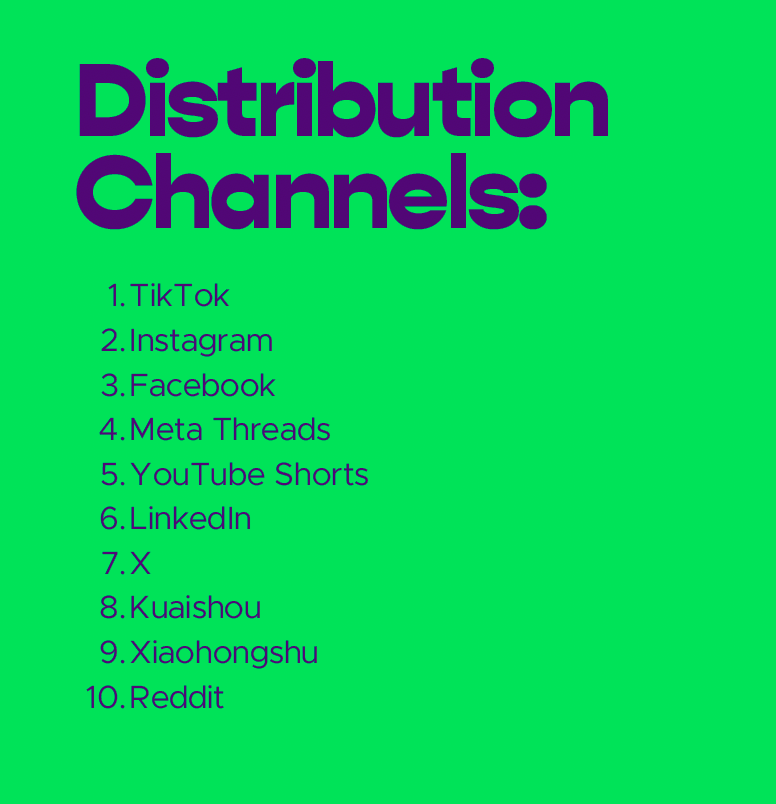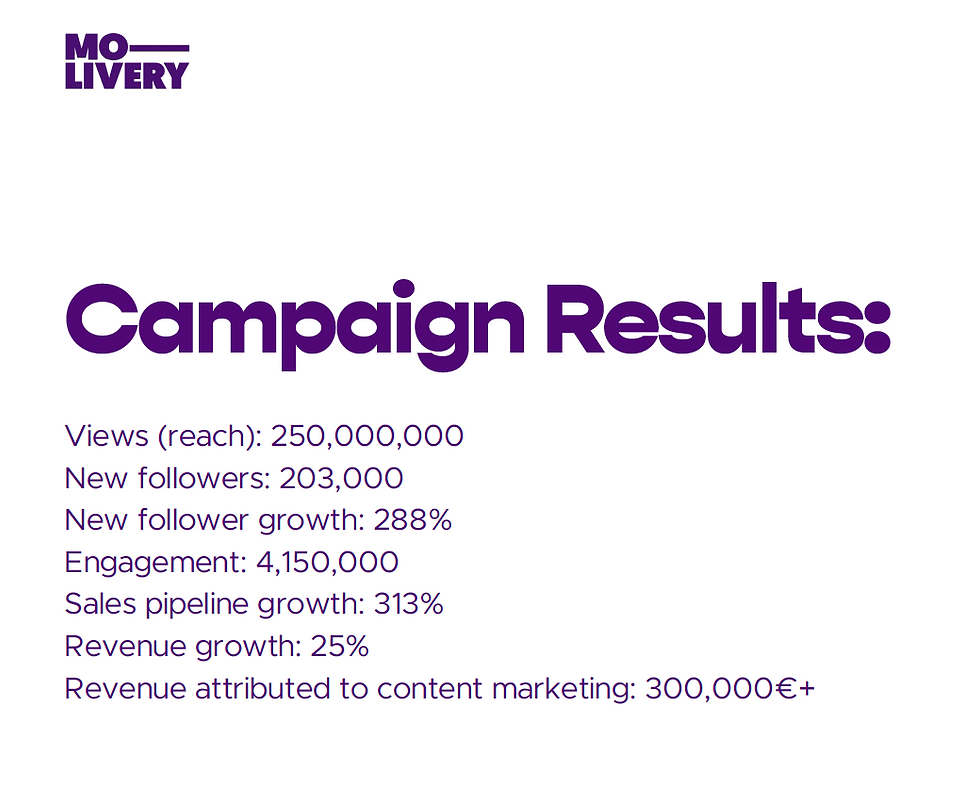CASE STUDY: How Dipperfox’s Stump Grinder Videos Got 250 Million Views
- catlinpuhkan
- Jul 9
- 8 min read
Interview with Taavi Altpuu, CEO of Molivery, the agency behind Dipperfox and winner of the Golden Parrot B2B Awards.
Dipperfox’s cutting edge technology clears tree stumps in seconds. The company started from rural Estonia and now has clients all over the World - from New Zealand to New York.Their marketing strategy is based on short videos - such videos have gained 250 million views so far.

How did the viral success of Dipperfox's videos begin?
It all started rather accidentally. The son of the Dipperfox owner, who was about 16 at the time, suggested posting a video on TikTok. That was their very first post, and it got six million views immediately. No one saw it coming.
After that, the comment section lit up, and inquiries started coming through the website, especially from the U.S. They tried posting again, but only about once a month, and it didn’t lead to much, maybe one video reached 15,000 people. They didn’t know how to consciously use the potential. They assumed that if something went viral once, it would again, but that wasn’t the case.
Has anyone tried to analyze why that first video went viral?
Our opinion is that it happened at a time when TikTok was breaking through in the U.S. and Europe. There wasn’t much competition for content, and the algorithm was showing almost everything.
That first video got engagement simply because the platform needed something to promote. Later, when they tried again, competition had grown, and success didn’t come as easily.
When did consistent activity start?
In 2023, the Dipperfox owner came to us asking how to grow sales. We did an analysis and saw that TikTok's potential was completely untapped.
Meanwhile, platforms like YouTube Shorts, Facebook Reels, Instagram, and even Threads had emerged. A well-made short video can be shared across multiple platforms, increasing the chance of going viral. We decided to focus on that.
What’s the creative strategy for these short videos?
We emphasize the satisfaction of watching the grinder in action. Even if someone isn’t our target audience, they might still share the video with friends if it’s exciting. That creates broader virality, which eventually brings us to the right contacts, like landscape contractors or arborists, who can be hard to reach on LinkedIn.
Who is your main target audience?
Landscape companies, arborists, and excavator rental firms — those are the three core segments.
The machine costs between €12,500 and €30,000, so it’s clearly for business buyers. Though one person in Estonia did buy one for personal use but that’s an exception.
Which markets are you targeting specifically?
We took a two-tiered approach. First, we post short videos organically to various global platforms and see where they gain traction.
Second, we selected three specific markets (Latvia, Slovenia, and Croatia) where we used the same content for paid ads and to find distributors. And within four months, we found distributors in all three.
How are the videos produced? What’s the script like?
By now, we have a pretty clear idea of what works. The most important thing is sound — the cracking, grinding noise that people love. ASMR works very well! We choose dense wood for this, like oak.
Second is the angle: the logo must be visible, because many viewers don’t visit the profile — they just go to Google. But the logo shouldn’t look too "marketed", the video has to feel authentic and user-made.
Then there's the hook. Our main message is: one stump in 15 seconds.
Later, we experimented with longer videos that show more context — forest, excavator, etc. For example, “two stumps in one minute” works well. When we go more educational, we also bring in people to explain the machine’s technical advantages.
Have you tried more entertainment-based approaches, like characters and competitions?
Not really. We haven’t done entertaining “man vs. machine” stories, we focus on more educational ones. But we’ve done comparison videos: Dipperfox vs. chemicals. Removing a stump with chemicals takes two months, with our grinder 15 seconds. That works great: people comment, tag friends, and engagement grows.
What’s the biggest lesson in terms of distribution?
Focus on quantity! You have to post as much as possible, at least once a day.
Initially, we did nine posts a month, then increased the tempo. We test different posting times, but in the end, content quality matters most. For some videos, we test multiple versions: change the text, intro, or sound, and repost.
Can you predict what will go viral?
Absolutely not. But you can do prep work, the first few seconds must grab attention, and the story should keep people watching to the end. We also add text, where it was filmed, what kind of tree stump is being drilled, etc. Specialists ask for specifics. That kind of content improves engagement and sparks conversation.
How does a viewer move from watching a viral video to becoming a lead?
That part (the “middle layer”) is critical in the sales funnel. Organic content on TikTok, Instagram, YouTube Shorts, brings massive views, but those viewers vary in interest level. Some just enjoy the sound or visuals, some comment or share, and a few are serious prospects. Our goal is to identify the truly interested ones.
This is where platform tools come in, we create custom audiences based on who watched the videos. For example, if someone watches at least 95% of a video, that’s a strong indicator of real interest. We build a separate audience from those viewers and then serve them targeted ads.
These ads don’t need to be broad or introductory — we can go into technical specs, show client stories, or offer direct contact with a distributor. At this point, the lead is “warmed up,” so the next step happens more smoothly than with a cold audience.
In short, organic content works like a filter — it helps us find the ones who really care. Paid ads take them to the next step — whether that’s a contact form, product page, or direct sales. This combination works very well, especially in B2B, where the sales cycle is longer and trust-building takes time.
Which platforms allow this kind of audience targeting, and how does it work?
This depends on the platform. The best tools are on Facebook and Instagram, in Meta’s ecosystem. There, you can build audiences based on who watched 50%, 75%, or 95% of a video. We focus on 95%. If someone watches a video almost entirely, we treat it as a sincere sign of interest.
Then we show them the next-level content like product info, a contact invite, or even a personalized offer. That way we’re not wasting ad budget on cold traffic. TikTok’s targeting is a bit more limited. You can target by views, but the settings aren’t as flexible as Meta’s. YouTube and Google also offer good options — you can retarget based on video views or website visits, and tie that into Google Search or Display ads.
Search behavior also plays a big role. Someone might see a video and not click, but later search “Dipperfox stump remover” on Google. We’ve seen brand search and site traffic spike after viral videos. While we can’t link it directly to a single video or user, it confirms the video had an impact.
But aren’t TikTok, Instagram, and other mass platforms more B2C-focused? Are they suitable for B2B marketing at all?
That was our big question at the start too. The classic B2B approach is direct: get contact lists from industry associations, send personalized emails, or connect via LinkedIn. We’ve tried that, and while it can work, it has a major downside: those lists are often incomplete. Many prospects aren’t part of formal associations, their contact info isn’t public, or they don’t respond to cold emails.
Our advantage is that Dipperfox is visually compelling — it works great on social. People don’t need to be in a professional group to see the video. If it’s interesting, it gets shared — people tag friends, comments explode, and organic reach grows. This visibility often hits people we’d never reach through classic B2B methods.
So to sum up: mass platforms work really well in B2B, if your product is eye-catching and the strategy is well thought out. The interest from organic reach can be filtered, qualified, and guided — using paid ads and retargeting tools.

Dipperfox also has a world-famous fan: Jeremy Clarkson.
This story started unexpectedly in March 2024 when we noticed Jeremy Clarkson had liked one of our older Instagram Shorts. It wasn’t even a fresh campaign, just a recycled clip. As the video started gaining views: several million in three days and we investigated who was engaging with it. Clarkson’s profile stood out. We confirmed it was the real Jeremy Clarkson.
Looking at his recent posts, we saw that in February he had started clearing forest on his farm, so we figured he probably had stumps to remove. We tried to contact him through multiple channels: Instagram messages, email, various platforms. No response. So we launched a targeted paid ad campaign in his farm’s region. We used the same video he liked, plus a few educational ones. The ads ran for two months, but no response.
But in August we got a call from Clarkson’s production company. They were looking for a stump grinder like Dipperfox and couldn’t find one in the UK. They asked if we could deliver it quickly. Two days later, it was there. Then it turned out that the stumps at the filming location were too small for dramatic effect, so they brought in bigger ones.
Filming was completed, and we heard nothing for a while. Finally, in May 2025, Season 4 of Clarkson’s show aired, and in Episode 7, our grinder was clearly shown. Clarkson explicitly praised the tool multiple times. That was a strong endorsement, even though it wasn’t contractually arranged.
Are you allowed to use that clip officially in marketing?
Not officially. Before filming, we signed an agreement that forbids disclosing the production or association before airing. Now that it has aired, we can mention it — in a blog, newsletter, or word of mouth. But we can’t use any clip or visual in ads or paid campaigns. That restriction still applies if we wanted to run an ad with the video. We can’t do that!
But people have started sharing screenshots or clips from it themselves, especially on Reddit, giving us extra visibility. We didn’t initiate or direct this organic spread, but it proves how valuable indirect visibility can be when the product is interesting enough.
What are the main lessons from Dipperfox's social media marketing?
Produce a lot of video content. If you have a physical product, especially a visually compelling one like our stump grinder, video is the best way to show how it works and why it’s better.
Don’t rely on a single platform. TikTok worked great for us, but the same content (with small tweaks) worked on Facebook, Instagram, YouTube, and even LinkedIn. Every channel has its audience and algorithm. The more platforms your content reaches, the bigger your potential impact.
Constantly track what works and what doesn’t. We don’t create based on gut feeling: we analyze numbers: views, engagement rates, comments, shares, formats, messaging. Based on that, we refine the content, cut the video shorter, change the intro, or test different tones.
Most important: connect marketing and sales.
The sales team must systematically track where each lead came from. It’s easy for someone to say “I saw you somewhere,” but without clear traceability, you can’t tell what content or channel actually worked.
ROI becomes speculative. So the chain from marketing to sales must be tightly linked, with two-way communication.



